Autumn SongJohn Conomos’s Work of Mourning
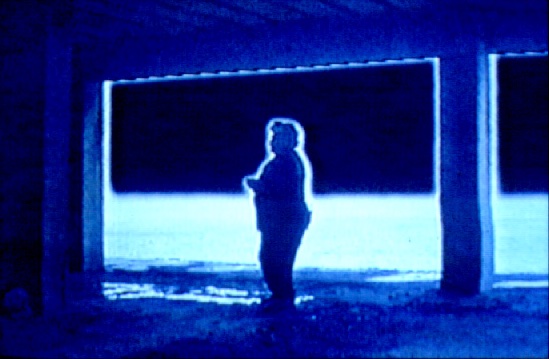
‘…somewhere a coffin is hastily being nailed
Charles Baudelaire, ‘Autumn-Song’
together – and for whom?’
‘The greatest mystery is not that we have been flung at random between the profusion of matter and of stars, but that within this prison we draw from ourselves images powerful enough to deny our nothingness.’
André Malraux, Anti-Memoirs
The electronic arts, video and television, have long been regarded as film’s poor relation, and despite the advances in technology which have rendered most of the negative comparisons invalid (the lack of clarity of sound and image and so on), this condescending attitude persists. Writing of video in the early 1990s Fredric Jameson observed, ‘nothing here haunts the mind or leaves its after-images in the manner of the great moments of film…A description of the structural exclusion of memory, then, and of critical distance, might well lead into the impossible, namely a theory of video itself – how the thing blocks its own theorisation, becoming a theory in its own right.’1
Jameson’s view of video art as possessing an inherently static and amnesiac nature can be compared to Baudelaire’s sarcastic polemic against the ‘photographic industry’ in his ‘Salon’ writings of 1859. Declaring photographers to be either failed or lazy artists Baudelaire warned that the utmost vigilance was needed to prevent ‘art’s most mortal enemy’ taking over as the dominant mode of recollection. ‘Let it hasten to enrich the tourist’s album and restore to his eye the precision which his memory may lack, let it adorn the naturalist’s library and enlarge microscopic animals, let it even provide information to corroborate the astronomer’s hypothesis…But if it is allowed to encroach upon the domain of the impalpable and the imaginary…then it will be so much the worse for us!’2 Photography’s recording nature, its implacable drive to ‘exact imitation’, precludes it in his view from ever being able to represent the impressionistic and mercurial form of memory and modernity. Only an aesthetic utilising both analytic and synthetic techniques will have the necessary transfigurative power to match the dynamism of the new age. ‘Modernity is that which is ephemeral, fugitive, contingent upon the occasion.’3
The dangers in attributing an ontological essence to any medium have never been clearer than at the present moment, when the increasing use of digital and computer technology across the field of media requires a reconceptualisation of what is meant by terms such as ‘photographic’ and ‘filmic’. Paradoxically, the recording ability of photography, its distinguishing feature for Baudelaire, is most often in the 1990s simply a means to a very Baudelairean end – the decomposition and recomposition of the image after the preliminary ‘capture of reality’. Digital and computing processes are now also increasingly incorporated into film, so that the ‘great moments’ of cinema of which Jameson speaks so nostalgically may well be, in the future, those produced through the use of electronic tools.
The work of Sydney video artist, John Conomos, offers a challenge to Jameson’s assertion that electronically produced images and sounds lack the generative power of the traditional media. Conomos argues that the particular use of language and technique is the decisive element in the dynamics of the media arts. ‘If we are to make images, sounds and music that stretch the present limits of our definitions of film and video, then we need to create, as Deleuze reminds us, as if we were foreigners in our own language.’4 In addition to cultivating an awareness of the strangeness of the familiar, for Conomos the search for a creative language is linked to the concept of ‘writing’ as theorised by Astruc, the Surrealists, Barthes and Godard.5
Astruc, an avant-garde filmmaker of the 1930s, uses the term ‘camera stylo’ to describe the moving image’s equivalence to a pen. Barthes goes beyond this notion of a fluid physical process in his proposition that writing does not fix meaning but constructs a palimpsest which retains, ‘memory’s form but not its content…what has been written continually returning in what is written.’6 This belief in the double nature of the extant moment is shared by the Surrealists for whom the concept of ‘automatic writing’ refers to a manner of accessing the unconscious in order to break down the dichotomy between ‘inner’ and ‘outer’ worlds. For the Surrealists, the technique is also inseparable from their Baudelairean view of the world as composed of signifying elements – a form of ‘automatic writing’ in itself. The modernist film maker Godard’s concept of writing is similar to Barthes’ in that it is through the process of ‘writing’ that memory traces are manifested. Noting Godard’s plea for art forms to remember the past in order that they be capable of addressing the future, Conomos has argued for film and video to function as a ‘theatre of memory, as passion’.7 In his own installations and tapes he frequently combines an autobiographical theme which centres on the search for origins with various electronic ‘writing’ and performance strategies through which it is made clear that memory can never simply be presented, only represented.
Autumn Song’s initial image is of a mountainous Greek island surrounded by the Aegean sea. In filmic terms this would have been the ‘establishing’ shot, indicating the major theme of this autobiographical piece – the journey to the Greek island home of the author’s parents. But no sooner have we sighted the island than its outline is shawled in a nimbus-like ‘cloud’, and it metamorphoses into a rock. A rope dangles into the frame followed by hands which loop the rope around the rock. The metonymic thrust of the image track, its rapid melding of images through the technique of ‘morphing’, recalls both Barthes’ argument that writing should function as a palimpsest and Baudelaire’s plea for an aesthetic that involves the ephemeral, synthesising elements by discovering their relevant associations. The contours of the three images – nimbus, island, and rock – ’correspond’, each metamorphosing into the other. The effect of these shifts is a surrealistic disruption to the time and space of narrative as the rock takes on the scale of the island and becomes a sculpture-like object in space. Nonetheless, the soundtrack stabilises the play of images, the first-person narration establishing that we are going to be told a story, ‘As a child I was often told of Uncle Manoli. ‘Come on John do your job or you’ll turn out like your Uncle Manoli’. This was a constant refrain puncturing my childhood like a looming rain cloud. Who was Uncle Manoli living far away on a Greek island called Kythera? What did he do that made my parents and relatives warn me about him?’
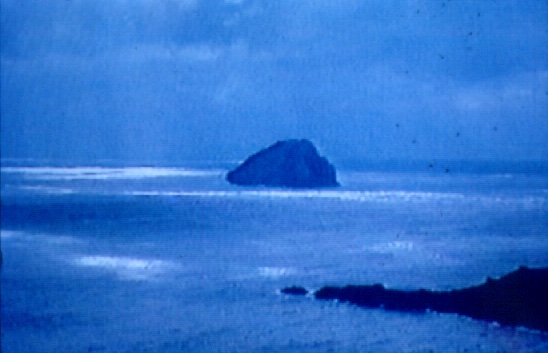
Through the recounting of the parental interdiction and the subsequent implied identification of the narrator with his uncle, two motifs are established – the outsider and the double. A later comment, that in order to negotiate both Greek and Australian cultures he was ‘forced to read between the lines, to scramble the codes, gestures and masks,’ is underscored by a succession of images of ‘alter egos’, including masked figures borrowed from Georges Franju’s Jude, and Chris Marker’s La Jetée. Not only do these sightless figures remind us of the way the twentieth century imaginary is permeated by the fantastic, they are also part of the dialectic of seeing and not seeing so central to Autumn Song. There is, for example, a scene where the author and cinematographer set up camera and tripod on a cliffside of Kythera. We see them checking the field of vision and, just as swiftly, there is a dissolve to a hood-covered figure, a silent witness standing motionless. This doppleganger figure appears to be, from its outline, the narrator in disguise. Its presence is uncanny because, as in a horror film, an illusion is created whereby only the spectator seems to be privy to its presence. In this figurative representation of Baudelaire’s concept of the author as simultaneously self and other, Conomos draws attention to the conundrum of the autobiographical piece. The indeterminate nature of the figure suggests the difficulty of ever ‘seeing’ oneself while, at the same time, the covered face, like the masked figures in Autumn Song, signifies ‘otherness’, indicating that his sense of identity is not to be found in his physical person or in his Antipodean and Mediterranean heritage but in the locus of the imaginary, the source of his identity as a writer and an artist.
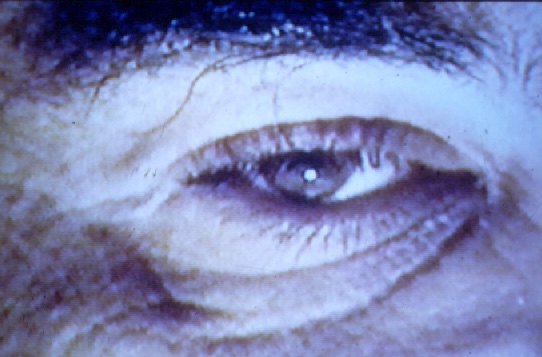
The first image of the narrator is related to the opening collage of rock, rope and water. He advances towards us bearing the rock in his hands, almost as if in the act of offering a gift. This Cassandra-like figure of fate (a leitmotif from an earlier work) whose gaze directly and discomfortingly engages us, becomes part of the narrative enigma. As in a fairytale, three times thereafter, he appears carrying the rock. But despite these early warnings, we do not fully comprehend the import of the image until just before the video ends. In the absence of a linear narrative, such motifs establish the structural rhythm and meaning of Autumn Song. Thus a series of rotating clockwise and anticlockwise shots are imbued with a similar sense of foreboding. They begin with an image of the child Conomos throwing back his head in a swooning gesture – a moment of ecstatic reverie – and end with melancholic images of the adult narrator lying motionless, eyes closed, on the bed.
The mimesis of alienation through camera angles is also evident in an angled shot of the narrator, dressed in suit and tie, paranoically edging backwards and forwards along a wall covered with the scrambled letters of the Greek and Roman alphabets. As in expressionist films, the distortion indicates the loss of ‘groundedness,’ the mental malaise of the narrator. His entrapment between two languages and his lack of mastery of either appear to excommunicate him from the male bourgeois world, yet a subsequent scene, a clip from the 1930s avant-garde classic Entre’acte, suggests that this alienation is not necessarily negative. In surreal slow motion a crowd of impeccably suited men race each other down a street – director René Clair’s metaphor for the absurdity of the bourgeoisie’s competitive pursuit of success.
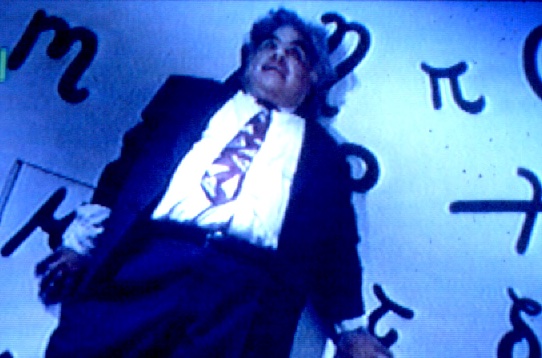
An apparent contrast to the anxious aesthetic of disorienting camera figures and expressionistic angles occurs with a scene in which the narrator ‘performs’ a graceful waltz in the oneric space of an empty building, an open air structure looking on to the Aegean sea. While the image suggests a harmonious relationship between place and person, the island homeland of the narrator’s parents offering him access to a sensuous self inaccessible in the country of his birth, nothing is as it seems, as a repetition of the same scene in different colours indicates. These colour contrasts disrupt the idyllic quality of the moment by demonstrating the perspectival nature of representation and by playing with the spectator’s powers of recall. The image, and others like it, show how colour has an affect as well as an effect, reminding us of the way in which the formal elements of a work contribute to its content. At times the frame is treated like a canvas, so that a street scene predominantly blue in tone but with flashes of hot pink and red, surprises the eye and carries a sensual shock reminiscent of the modernist colourists. Another street scene is rendered in ‘black and white’, an allusion this time to photography and film.
The narrator’s recollections of his childhood remind us of our own archaic impulse towards magic as children. For the young Conomos the television at the local pub, which the neighbourhood children run to gaze at through glass doors, is a magical agent transporting him from the banality of the working-class suburb of Tempe to the American dream world of The Untouchables, Rawhide, and Sunset Strip. The endless hours of waiting for customers in his parents’ milkbar are also magically contracted by his willed transformation of the door into a movie screen upon which the everyday activity of the street outside is transfigured in a world of enchantment. As he recounts the story of his transformation of the door into a screen the accompanying image is of his ‘Kythera waltz’ so we are invited similarly to transform the space beyond the building’s columns into our own fantasy movie.
Like Godard, Conomos seeks to invoke ‘traces that resemble us’ in his creation of video as a theatre of memory. Such memory-work includes images of useless everyday objects – an empty bottle, tattered paper, a dead bird beached on its side yet ‘swimming’ in a flux of pixels which invoke the surrealist aim of restoring an epiphanic meaning to the object trouvé. On the other hand, the historical dimension of the technology which mediates our ways of seeing and hearing is drawn attention to through a McLuhanesque tableau, a composition in fantasy colours of deep blue and crimson, in which an old radiogram is flanked by two men gazing at each other through telescopes while overhead an electric light bulb swings back and forth. The electric light bulb, a symbol of the new electronic technologies, is an image borrowed from Jean-Paul Fargier, the video artist whose work Conomos acknowledges elsewhere to be an important influence. Another of the many technology references occurs with the brief flashes of family photography, an allusion to the centrality of the photograph in the diaristic and autobiographical independent films of the 1970s. In contrast to the referential ‘truth’ of the informal snapshot, Conomos’ self-portraits involve highly stylised performances or images of himself in which the lighting and pose allude to classic fine arts portraiture.
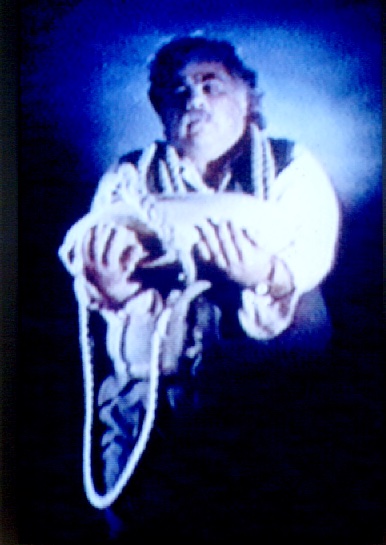
Classic representation is also invoked in the image of the solitary figure of the narrator wandering through the forest of Kythera. These scenes bring to mind the paintings of the nineteenth century Romantics, while the metamorphoses of trees and meadows into sea-like waves is a modern realisation of the Baudelairean dream of a radical aesthetic of nature where, ‘there is full licence for everything to be as green, red, dusty or iridescent as it wishes; where all things, variously coloured in accordance with their molecular structure, suffer continual alteration.’8 As the narrator moves across the field of ribbony grey and green shapes which undulate horizontally across the screen, the movement of his figure in time and space produces a trompe l’oeil ‘filmic’ effect, an illusion of a ‘real’ offscreen space beyond the frame. But almost straight away the ‘reality-effect’ disappears as the figure/ground relationship becomes increasingly interwoven with a surface patterning and the landscape dissolves into pixilated vertical grids – the ‘organic’ becoming ‘inorganic’ as columnlike structures (perhaps Greek colonnades) emerge from the abstract patterning of the flow of electrodes. This dialectic between the organic and inorganic also occurs in the soundtrack, where various sounds bleed into each other, the wind or a human chant becoming an eerie electronic hum, while in turn such ‘inorganic’ sounds contrast with the ‘grain’ of the narrator’s voice, which has the expressive intimacy we associate with the art of storytelling.v
The journey to the Greek island of Kythera inevitably invokes Homer’s Odyssey. For Odysseus – the ‘Greekest of the Greeks’ – the journey is inseparable from notions of self and home. One of the great epiphanic moments in the epic occurs when, on the last leg of his wanderings, he dramatically reveals his identity and origins, ‘I am Odysseus, son of Laërtes… My home is in Ithaca, fair in the evening light.’9 In exilic tales the denouement is in the ‘return’, but in Autumn Song the sense of a movement between the strange and the familiar, with a resolution in the familiar, is lost or, at times, as with the Surrealists, reversed. Thus the milkbar door becomes a passage out of the suffocating familiarity of ‘home’, while a reading from Michel Serres about the difficulty of negotiating the passage between the Atlantic and Pacific oceans is whimsically illustrated by a clip from Buster Keaton’s 1926 film The General. A forlorn Johnny Gray (Keaton) sits on the connecting-rod of a locomotive which suddenly takes off, forcing him to go ‘round in circles’, so becoming a metaphor for the video’s theme of ‘inbetweenness’. This motif of homelessness is inseparable from Conomos’ journey to Kythera, which involves a confrontation with his childhood imaginings and projections (in particular, his identification with his uncle Manoli), and demonstrates their fictional base.
That the island can never be more than a myth is made clear in the way that it is presented. The initial ‘haloed’ effect imbues it with a numinous quality, while subsequently it is always viewed from afar, framed from the vantage point of cave or vegetation as if from a Romantic landscape. (At one point there is, in fact, a subliminal flash of Watteau’s Embarkation to Cythera). The protracted silent takes of men drinking and playing cards in the tavern also convey the impression of temps mort, while a sense that the island is outside time is repeated in the narration, ‘island of wild herbs, stormy seas, deep ravines, braying donkeys, almond trees in the dusk, empty broken-down houses, desolate village squares and de Chirico clock towers.’
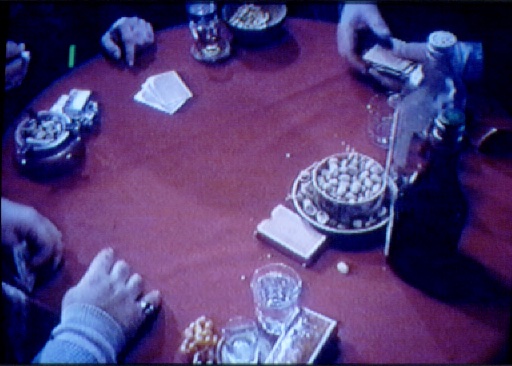
Uncle Manoli with ‘his spitting tick in unison with his worry beads’ is the important but absent figure in Autumn Song. His death by suicide – which we learn of only at the end of the tape – is the mise-en-abîme which, retrospectively, can be seen to structure the narrative. Thus it is not until Conomos enacts the imagined scene of his uncle’s agitation and vertigo before his death (when he throws himself down the well) that we realise that many of the previous images, the initial rock and rope, the funereal motif of the narrator carrying the rock (the insistent repetition of the labour of mourning), the spectral figures and the delirious angled shots, have been preparing us for this moment.
Both of Baudelaire’s poems ‘Autumn-Song’ and ‘A Voyage to Cythera’ contain apocalyptic images. The latter includes the following lines, ‘The sky was entrancing, the sea was calm, but for me all was now dark and smeared with blood…I found nothing but a symbolic gallows, with my own image hanged upon it.’ Baudelaire’s portentous images of death and the double appear to fit uncannily well with those of Autumn Song, while the tape’s overall aesthetic, its dialectic of decomposition and recomposition, fullness and emptiness, would seem to exemplify the poet’s call for an aesthetic to match the endless flux of modernity. Autumn Song is Conomos’ reading of himself as formed by the dynamics of the media of the twentieth century – those ceaseless exchanges between modernist and realist art and literature, the film avant-garde, Hollywood and television. The tape functions both as a memory-text, with all the condensations and slippages which characterise the ephemeral structure of memory, and as a reflection on modes of representation.
The complex motif-structure allows for an interweaving of discourses and anecdotes, allusion and auto allusion. While this may suggest a tiresome game of ‘trivial pursuit’, or what Jameson describes as the dead language of pastiche, text and image retain their potency, often triggering our own associative links. It is precisely Conomos’ ability to preserve the critical distance – which Jameson argues the medium itself necessarily blocks – and, at the same time, to invoke the lyricism and empathy of traditional autobiography, which makes the work interesting.
Autumn Song is not, in the final analysis, any more Baudelairean than it is the work of a boy with a toy, demonstrating by facile mimesis that video techniques such as morphing and nonlinear editing can best represent the postmodern concept of a constantly ‘remakable’ self. Although the author’s mask gives way to other masks and there is a sense that we ‘write’ ourselves in the telling of ourselves, Autumn Song is not a celebration of the ‘death of man’. Rather, it is a work of mourning, an expression of grief stemming from a sense of incompleteness, a condition which for his uncle can only be resolved by the finality of self-annihilation.
The metonymic dynamic of the tape means that it constantly folds in on itself. In his discussion of his concept of writing, Barthes uses the symbol of the spiral to describe such a process of repetition, and it can be argued that the image of the rock in Autumn Song travels a similar circuit.10 It also represents the ultimate impasse of representation in that a virtual apprehension of its real weight is impossible. In this sense its representation has no more substance than one of Magritte’s surreal images of airborne boulders. What disturbs the Barthesian movement of ‘infinite circular transcribility’ is then, the unrepeatable moment of real death. It is the death of the narrator’s uncle and the abject nature of its detail (the horror of the choice, the well, symbol of life and sociality in the ancient world) which reminds us of the one thing of which language and images can never speak with real authority.
Notes
1 Fredric Jameson, Postmodernism, the Cultural Logic of Late Capitalism (Durham, 1991), p.80.
2 Charles Baudelaire, ‘Salon of 1859’ in Art in Paris 1845-1862; Salons and Other Exhibitions, trans. & ed. Jonathon Mayne (London, 1965), p.80.
3 Charles Baudelaire, My Heart Laid Bare and Other Prose Writings (London, 1986), p.37.
4 John Conomos, ‘Perspecta 1989, John Conomos’, in Photofile, no 19, p.31.
5 John Conomos, ‘The Movement of Shadows – Video as Electronic Writing’, Art and Design, no.45.
6 Roland Barthes, The Responsibility of Forms: Critical Essays on Music, Art, and Representation, trans. Richard Howard (London, 1985), p.221.
7 John Conomos, ‘The Movement of Shadows’, p.39.
8 Charles Baudelaire, ‘The Salon of 1846’, in Art in Paris, p.48.
9 Homer, The Odyssey, 9:1921, trans. & cit. by W.B. Stanford in The Quest for Ulysses, ed. W.B. Stanford & J.V. Luce (London, 1974), p.48.
10 Roland Barthes, The Responsibility of Forms, p.220.

